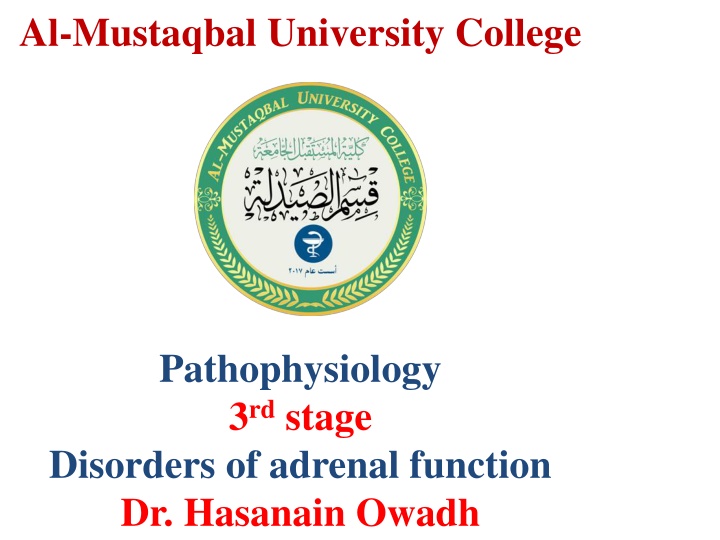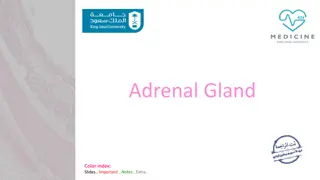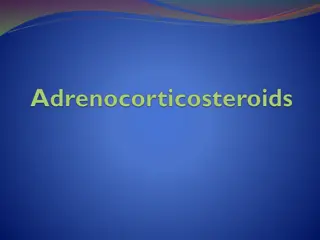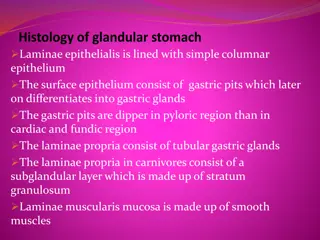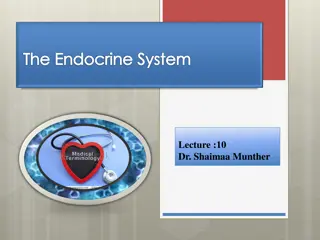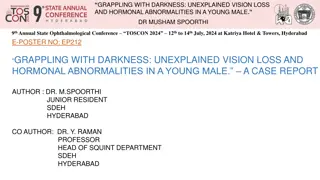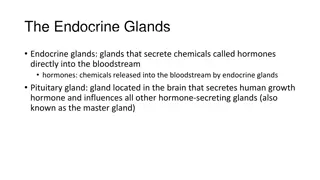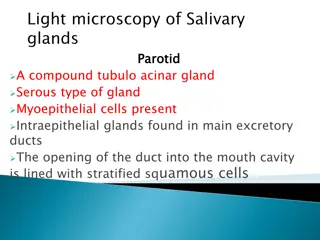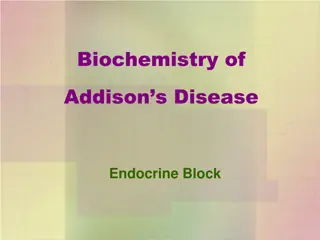Adrenal Glands and Their Hormonal Functions
The adrenal glands, comprised of cortex and medulla, play a crucial role in hormonal regulation. Factors influencing CRH and glucocorticoid release, along with their effects on metabolism, are explored in detail.
Download Presentation

Please find below an Image/Link to download the presentation.
The content on the website is provided AS IS for your information and personal use only. It may not be sold, licensed, or shared on other websites without obtaining consent from the author.If you encounter any issues during the download, it is possible that the publisher has removed the file from their server.
You are allowed to download the files provided on this website for personal or commercial use, subject to the condition that they are used lawfully. All files are the property of their respective owners.
The content on the website is provided AS IS for your information and personal use only. It may not be sold, licensed, or shared on other websites without obtaining consent from the author.
E N D
Presentation Transcript
Al-Mustaqbal University College Pathophysiology 3rdstage Disorders of adrenal function Dr. Hasanain Owadh
Adrenal Glands The adrenal glands are paired, pyramid-shaped organs behind the peritoneum and close to the upper pole of each kidney. Each adrenal gland consists of two separate portions an outer cortex and an inner medulla.
Adrenal Cortex The adrenal cortex accounts for 80% of the weight of the adult gland. The cortex is histologically subdivided into the following three zones :1. The zona glomerulosa, the outer layer, primarily produces the mineralocorticoid aldosterone. 2. The zona fasciculata, the middle layer, secretes the glucocorticoids cortisol, cortisone, and corticosterone. 3. The zona reticularis, secretes adrenal androgens.
Factors Controlling CRH 1- CRH is secreted from the hypothalamus in a diurnal pattern that sets the subsequent release pattern of ACTH and cortisol. Stimuli for an increase in CRH include: 2- Stress. 3- Hypoglycemia (low blood glucose). 4- Decreased circulating levels of glucocorticoids.
Glucocorticoids: Glucocorticoids are steroid hormones released from the adrenal cortex that affect many aspects of metabolism, especially glucose metabolism. In humans, the main glucocorticoid is cortisol. The glucocorticoids also affect many other systems of the body, including the cardiovascular and immune systems. Glucocorticoids are released in a diurnal (daily) manner, peaking in the early morning hours.
Factors Controlling Glucocorticoid Release adrenocorticotropic hormone (ACTH) from the anterior pituitary (AP). ACTH is released in response to corticotropin-releasing hormone (CRH) carried in the portal blood from the hypothalamus. CRH also stimulates the release of endorphins by (AP) When released, glucocorticoids feed back on the hypothalamus and on the AP to decrease the further release of CRH and ACTH, respectively.
Effects of the Glucocorticoids: 1- Increase the level of blood glucose by stimulating gluconeogenesis (conversion in the liver of fats and proteins into glucose). 2- Stimulate protein breakdown and inhibit protein synthesis in all body cells. stimulate hunger. 3- Promote fat buildup in the trunk and face. 4- Inhibit growth by suppressing growth hormone and antagonizing the effects of growth hormone on protein synthesis.
5- Increase the effect of growth hormone on adipose tissue and increase the effect of thyroid hormone on its target tissues. 6- Increase the effects of the catecholamines, causing increased heart rate and blood pressure. 7- Skin bronzing. 8- Strong effect on emotional stability and mood.
inhibition of immune and inflammatory functions by depress cytotoxic T-cell function and suppress the production, release, and activation of many chemical mediators of inflammation, including interleukins, prostaglandins, and histamine.
Disorders of the adrenal cortex Hyperfunction of adrenal cortex that causes increased secretion of cortisol leads to Cushing disease or Cushing syndrome. Hyperfunction that causes increased secretion of adrenal androgens or estrogens leads to virilization or feminization. Hyperfunction that causes increased levels of aldosterone leads to hyperaldosteronism, which may be primary or secondary. These syndromes often have overlapping features. Hypofunction or adrenal Insufficiency leads to Addison disease.
Adrenal Insufficiency Adrenal insufficiency is a decrease in the circulating level of the glucocorticoids. Adrenal insufficiency may be primary caused by dysfunction of the adrenal gland, or secondary caused by dysfunction of the pituitary or hypothalamus. Addison disease. Primary adrenal insufficiency is termed Addison disease. Addison disease is caused by autoimmune mechanisms that destroy adrenal cortical cells and is more common in women.
Pathophysiology Addison disease is characterized by inadequate corticosteroid and mineralocorticoid synthesis and elevated levels of serum ACTH (loss of negative feedback). Before clinical manifestations are evident, more than 90% of total adrenocortical tissue must be destroyed. Idiopathic Addison disease (organ-specific autoimmune adrenalitis) causes adrenal atrophy and hypofunction and is an organ-specific autoimmune disease. It may occur in childhood (type 1) or adulthood (type 2).
Clinical Manifestations Depression, because cortisol levels influence mood and emotions. Fatigue, related to hypoglycemia, and decreased gluconeogenesis. Anorexia, vomiting, diarrhea, nausea and weight loss. Hyperpigmentation of the skin if ACTH levels are high (primary adrenal insufficiency) as a result of ACTH having melanin-stimulating hormone like effects on the skin.
Sparse body hair in women, if the adrenal cells producing androgens are destroyed or if ACTH levels are very low. Inability to respond to stressful situations, perhaps leading to severe hypotension and shock.
Diagnostic Tools A good history and physical examination. levels of CRH, ACTH,. Hyponatremia, hyperkalemia, and hypotension may be present if the adrenal cells that produce aldosterone are destroyed or if ACTH levels are undetectable. Complications Adrenal crisis may occur after physical or mental stress in an affected individual. This can be life-threatening and is characterized by volume depletion, hypotension, and vascular collapse.
Treatment Glucocorticoid replacement such as the use of hydrocortisone or cortisone acetate is required (Health providers should monitor the history of glucocorticoid dose adjustments). Monitoring blood pressure, peripheral edema, serum sodium, serum potassium, and plasma renin activity provides clues to treatment efficacy. Aldosterone replacement (only in primary adrenal insufficiency) may be necessary. Glucocorticoid administration may need to be increased during periods of stress, including infection, trauma, and surgery. Morbidity and mortality are high without treatment. If the cause of adrenal insufficiency is related to a pituitary tumor, it may be treated with chemotherapy, radiation, or surgery.
Glucocorticoid Excess: It is any condition in which there are very high levels of circulating glucocorticoids. The cause of glucocorticoid excess may reside at the level of the adrenal gland or at the pituitary/hypothalamic level.
If the cause of glucocorticoid excess is primary adrenal gland hypersecretion, there is usually an adrenal tumor present. In this situation, low ACTH and low CRH levels will be present as a result of negative feedback from high glucocorticoids. Adrenal androgen levels will be low because ACTH is low. Bronzing of the skin will not occur.
If pituitary cells producing excess ACTH, the elevated ACTH also will cause excess adrenal androgen production. Bronzing of the skin will occur because of crossover effects between ACTH and melanin-stimulating hormone. CRH levels will be low as a result of negative feedback from ACTH and the glucocorticoids.
High levels of glucocorticoids also may result from chronic administration of high-dose corticosteroids, especially cortisol, for treatment of inflammatory conditions. Disease states in which long-term administration of corticosteroids occurs include asthma and several different autoimmune diseases. Cushing's syndrome refers to any condition of high glucocorticoids and includes glucocorticoid excess caused by therapeutic administration of corticosteroids.
Clinical Manifestations 1- Altered fat metabolism leading to fat pads on the face and back (rounded face or moon face and increase neck fat. 2- Muscle weakness from protein breakdown, and thinning around arms and legs. 3- Hypertension as a result of increased catecholamine responsiveness.
4- Weight gain resulting from strong appetite stimulation. 5- Because of effects on hepatic gluconeogenesis, a reversible form of diabetes mellitus may result. 6- Inhibition of immune and inflammatory reactions, leading to poor wound healing. 7- Extreme emotional lability.
8- Masculinization of women and children as a result of adrenal androgen stimulation. 9- Bone osteoporosis and fracture. 10- Bronzing of the skin if ACTH levels are high.
Diagnostic Tools A good history and physical examination. Blood tests measuring levels of CRH, ACTH. Loss of normal diurnal (morning) pattern of cortisol release. Hyperglycemia, hypernatremia and hypokalemia may be present because of aldosterone-like properties of the glucocorticoids. This can contribute to hypertension and cardiac and neural irregularities. A dexamethasone challenge test is commonly used in clinical practice to evaluate states of glucocorticoid excess. In healthy individuals, a low dose of dexamethasone will suppress ACTH secretion; in those with Cushing's syndrome, suppression does not occur.
Complications Morbidity and mortality are high without treatment and approximately 50% of individuals die within 5 years. Causes of death include suicide, overwhelming infections, and coronary artery disease from severe hypertension. Insulin resistance and hyperglycemia may develop in those with glucocorticoid excess. These may be due to abnormal changes in hepatic fatty acid metabolism.
Treatment Correction of high glucocorticoid levels depends on the cause of the problem. Surgery for tumors of the adrenal, pituitary, or other tissue (e.g., the lung) is frequently performed. Radiation therapy is done if a tumor is present. Drugs that block steroid synthesis may be used if the tumor is inoperable. Discontinue corticosteroid therapy, by weaning down, if syndrome is caused by medication.
Congenital Adrenal Hyperplasia It results from an inherited deficiency of an enzyme that is critical in cortisol biosynthesis. Because cortisol is not produced efficiently, the conc. of ACTH increases and causes adrenal hyperplasia, which results in the overproduction of mineralocorticoids or androgens, or both. Affected female children are virilized and may have genital ambiguity. Infants of both genders exhibit salt wasting. Prenatal diagnosis is available and treatment guidelines have been developed. Disease management requires lifelong treatment with glucocorticoids and mineralocorticoids.
Pheochromocytoma It results in the release of too much epinephrine and norepinephrine, hormones that control heart rate, metabolism, and blood pressure. It usually develops in the center (medulla) of one or both adrenal glands. Symptoms Most people with this tumor have attacks of a set of symptoms, which happen when the tumor releases hormones.
The attacks usually last from a few minutes to hours. The set of symptoms include: Headaches, heart palpitations, sweating, High blood pressure Treatment Treatment involves removing the tumor with surgery. When the tumor cannot be surgically removed, a combination of medicine will used to manage it.
Write 2 clinical manifestations differentiate between Addison's disease and Cushing disease?
